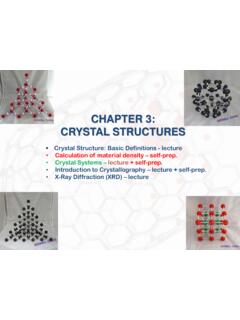Transcription of Space can be split into two categories: positive and ...
1 When thinking about interior design, words like creativity and flair immediately spring to mind but many would be surprised to find there is a degree of science involved. Professional interior designers will usually follow a set of informal rules , based on specific interior design principles and elements. These interior design elements include Space , line, forms, light, colour, texture and pattern; and keeping them balanced is the key to creating an aesthetically pleasing addition to enhancing the appearance of a room, getting these elements to work together in harmony will also bring an increased functionality.
2 To start, an interior designer will assess the room according to these interior design elements, and then use them to disguise or enhance the various features and flaws of the Space . As a minimum, the following seven elements should always be considered in the creation of any foundation of an interior, Space is a fundamental concept to understand, ensuring you re best equipped to take advantage of what is available to you. The available Space usually can t be easily changed (though sometimes a designer may have the luxury of doing so), so you need to work with what you have within the physical boundaries of the room.
3 In interior design we have the luxury of working within three dimensional Space (length, width and height). This three dimensional Space can be filled or left empty, depending upon what you need to achieve from a functionality and design Elements of Interior of 14 Space can be split into two categories: positive and negative Space . positive Space is Space containing objects, whilst negative Space is the open/empty Space (including any Space between objects). Striking a balance between the negative and positive spaces of a room is essential to avoid overcrowding, or on the other end of the spectrum, balance will be influenced by the client s needs in the specific area/room and its required functionality.
4 For example, negative Space is required for traffic paths. It is also crucial to consider the scale and size of the furniture and objects placed in a room, as this can be used to make the Space appear larger or smaller given the desired outcome. A tall object such as a book case can give the illusion of design styles will lend themselves to different uses of Space for example, a minimalist design will have far more negative Space than your average eclectic design. However, no matter what your design brief, how you use and balance the Space available to you can be the difference between hitting the mark with your design concept or missing out on your next , vertical and dynamic lines help to shape a room and guide the eye.
5 Creating lines using the room s furnishings and structural design can form harmony, unity and lines, created by tables and other surfaces, give a sense of stability, formality and efficiency. Interior designers highlight horizontal lines to make a room appear wider and longer, and to draw the eye to a focal point. But be careful, overemphasis of horizontal lines has the ability to make the Space seem boring and lines, created by features such as windows and doorways, evoke feelings of freedom and strength. On a functional level, accentuating vertical lines often gives the illusion of a room being taller.
6 Often suited to use in dining rooms, entries and offices, vertical lines must be incorporated wisely so as not to leave inhabitants feeling lines refer to diagonal, zigzag or curved lines. Such lines can be found in stairs, for example, and provide energy and movement. Stimulating to the eye, dynamic lines capture our attention longer. However, too many dynamic lines in one room can be distracting, and overpower horizontal or vertical , interior designers will strike a balance with the incorporation of different lines. This is typically done by selecting one dominant feature line, in accordance with the client s brief and the desired feeling they wish to convey in the is the shape of the room, as well as any objects within the room.
7 In other words, it relates to the physical form of anything that is three can usually be described as either geometric or natural. Geometric refers to hard lines and square edges, often looking man-made, while natural relates to more organic forms that seem to be created by nature. Forms can also be open objects that can be looked into or closed Elements of Interior of 24 Another thing to take into consideration with form is the proportions and scale of the room compare to the objects being placed within it. Adding forms of similar shapes can create harmony and balance, while adding too many differing shapes can have a confusing result.
8 A Space is typically more pleasing if the dominant form is repeated in minor objects throughout the or man-made light is a critical aspect of any Space . Without it, all of the other elements would not be able to shine to their full potential. Light can be broken into the categories of task lighting (defined purpose), accent lighting (emphasising objects) and mood lighting (adding ambience). When considering lighting, it is important to address the activities that will be undertaken in the Space . Both the quality and quantity should be assessed here. For example, an office will require bright lighting so that the workers can see clearly and act alert.
9 On the other hand, living room lighting can be applied with a softer touch. Applying a dimmer has the ability to make a Space much more versatile. Natural lighting should always be taken into consideration, and can be manipulated through clever placement of doors, windows and even its functional purpose, light has the ability to set the mood and atmosphere of a Space while defining colour, line and texture. Plus, any good interior designer also knows that the lighting fixtures are a visual feature in themselves, which can add the right tough to any is a science all on its own, and is another extremely important element that interior designers master.
10 It has the ability to create mood, define unity and alter the perception of how large or small a Space psychology of colour shouldn t be underestimated, and will be used to full advantage by any skilled interior designer. Colour can evoke memories and stir emotions, stimulating a physical and psychological response in our bodies. For example, greens and blues entice calmness and are suited to bedrooms, whereas red entices appetite and therefore often features in considering the colour of a room, first think about what the room will be used for and the activities that will occur in that Space .






